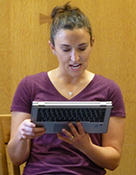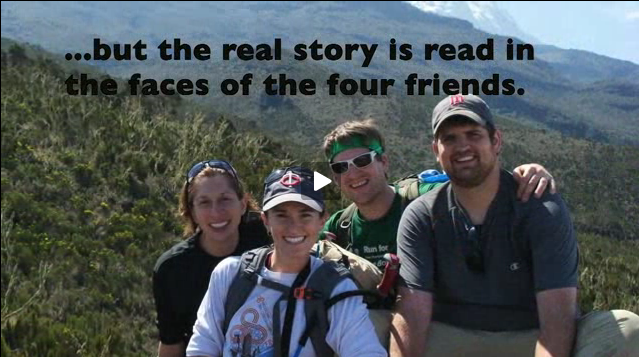- Campuses :
- Twin Cities
- Crookston
- Duluth
- Morris
- Rochester
- Other Locations

center for writing
mwp.umn.edu
Anne Sawyer Beach
©2014

Extreme Angle-Sampras-Bam
The summer I was 13 going on 14, my mom informed me that I was going to get off my “lazy butt and do something.” She marched me down to Edgcumbe Park for the noon tennis class. I had never swung a racket. I didn’t even own a racket. I was mortified.
Down at the courts, it was clear to me that most of the other junior high kids had grown up playing tennis or at least participated in the St. Paul Urban Tennis program for a few years. My mom pulled the instructor aside to discuss the logistics of the class. I couldn’t hear the instructor’s answers because I was too busy gawking at the extremely tall boys standing in a circle, hugging their rackets and exchanging emotionally charged thoughts about something called the “French Open,” but did catch a few tidbits from the conversation:
Mom: “It’s an hour every day? That’s perfect!”
Hmmmmm, I think that boy was an 8th grader at my school last year.
Mom: “See Annie, they have a racket you can BORROW!”
Whoa, that instructor looks like a darker haired version of Leonardo DiCaprio.
Mom: What a great price for six weeks of lessons! I’ll write you a check right now.”
Why is that girl wearing makeup?
Mom:“Oh, this is the advanced class? Well, she’s their age so I’m sure it will work out just fine.”
Wait...wha?
Mom: “She can just walk home when she’s done.”
And poof! She was gone. Just like that, I was an advanced tennis player with no prior experience, standing next to tall, handsome classmates, awkwardly gripping my borrowed, wooden racket, sporting my inch-thick bifocals and a bright red scrunchie, and frowning because my braces suddenly hurt. God, adolescence is cruel.
There was no time to complain, no chance to dash back to Mom (or the couch) whimpering from the intimidation and anxiety because we started running, as instructed by our high school and college aged tennis teachers. It felt . . . what was that feeling racing through my lethargic, 13-year-old body? It felt good! The nervousness quickly dissolved as I felt the summer air breeze through my hair, acquainted my muscles with a new, repetitive motion, heard kids chattering all around me, and saw the coaches smiling as they globbed sunscreen over their arms, necklines and noses. I ran home immediately after the class to insist on purchasing my first racket.
That summer, I was encouraged and inspired. I thrived. A confident, competitive part of me emerged. I learned sportsmanship, discipline, persistence. I remember the first time the instructors told me to play a full set, one-on-one, against another girl in the class. I felt honored. The intimidated feeling rushed back to me, but I also felt grown up, as if I had been trusted to stay home alone for an entire weekend. We were directed to the lower courts away from the rest of the class, and left alone to warm up, call our own lines, take water breaks, and compete, until one of us had to report back a winner. During the match, I noted the lack of usual banter from the coaches while they fed us balls for down-the-line drills, and I didn’t get any aid from classmates as they stood behind me cheering me to hit that dreaded backhand volley. There was only the ball to judge me as it sailed back and forth over the net, either long, short, or in. Every time I struck the ball, I was accountable for the positive or negative consequence, and I liked that. I didn’t really notice the girl across the net; I didn’t want to know her or be nice to her. I just wanted to get the ball back more times that she did. It was after that when I began to stay out each day on the courts challenging the boys until it was time to walk home for dinner.
A couple summers later, I became a St. Paul Urban Tennis coach myself and continued the tradition of “Catch Ball” with the little ones, “See-ya!” with the middle ones, and “Olympics” with the high-school aged kids every summer until I was well out of college. We started our own traditions, like yelling “Extreme Angle-Sampras-Bam!” when a kid hit a nice shot, teaching kids as young as four years old to swing while, more importantly, teaching them to shriek and grunt like pros Monica Seles or Jimmy Connors, and cutting off the arms and v-necking the crew-necks of our oversized, white cotton St. Paul Urban Tennis instructor t-shirts. We sweated out the hottest days and we waited out the wettest days. We would stand out on Harding or Central High School’s courts to line-judge for kids from all over the city at the big, end-of-summer tournament, while secretly wishing we could be back out there vying for one of those cheap, yet prized medals. It was, and still is, a great job.
Looking back, I’m confident I can credit the feats of trying out for and making both my high school and college tennis team to SPUT (our newer, guttural acronym). And even now, I still play with friends, new and old, at Macalester’s courts (new, bright blue and orange), Merriam Park (traditional and shady with a few cracks), Newell Park (right by the house we just bought), Central High (where the memories are so fresh I can still hear the “C-C-CEN-T-T-TRAL cheer), and Edgcumbe Park (where it all started).
Twenty years after I first stepped onto those city tennis courts, I rode my bike near Martin Luther King Rec Center and saw the high-school aged instructors in their stylish, dry fit, green SPUT t-shirts, gently tossing foam balls to a bunch of young kids and their families (including a grandmother with a walker!), and I realized why my mom had left me there that day. This sport, with all of its built-in life values, is helping to raise kids and families across our city—and not just raise them off the couch, but perhaps inspire independence with teamwork, confidence with sportsmanship, and leadership with discipline. That same day, I biked past a young boy balancing his junior size tennis racket on his bike to the courts. He was racing, determined to get there—perhaps he saw his future, with all of his wins and losses, and realized it all starts on those shady, cracked courts.
Four Friends, One Mountain




